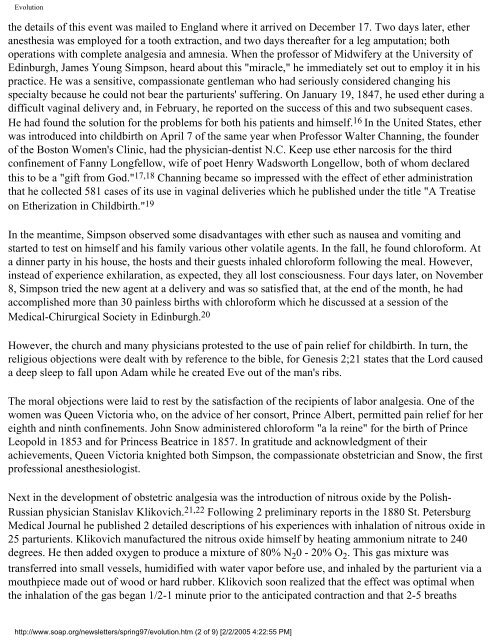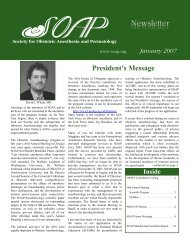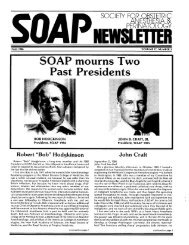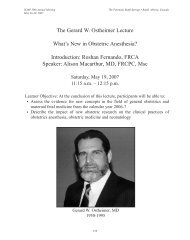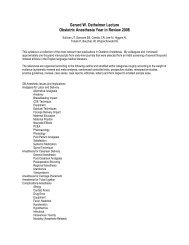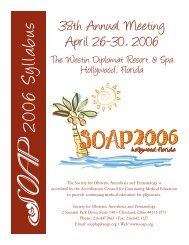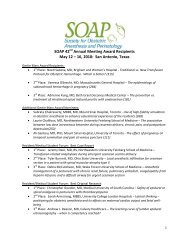SOAP Newsletter Highlights - Society for Obstetric Anesthesia and ...
SOAP Newsletter Highlights - Society for Obstetric Anesthesia and ...
SOAP Newsletter Highlights - Society for Obstetric Anesthesia and ...
Create successful ePaper yourself
Turn your PDF publications into a flip-book with our unique Google optimized e-Paper software.
Evolution<br />
the details of this event was mailed to Engl<strong>and</strong> where it arrived on December 17. Two days later, ether<br />
anesthesia was employed <strong>for</strong> a tooth extraction, <strong>and</strong> two days thereafter <strong>for</strong> a leg amputation; both<br />
operations with complete analgesia <strong>and</strong> amnesia. When the professor of Midwifery at the University of<br />
Edinburgh, James Young Simpson, heard about this "miracle," he immediately set out to employ it in his<br />
practice. He was a sensitive, compassionate gentleman who had seriously considered changing his<br />
specialty because he could not bear the parturients' suffering. On January 19, 1847, he used ether during a<br />
difficult vaginal delivery <strong>and</strong>, in February, he reported on the success of this <strong>and</strong> two subsequent cases.<br />
He had found the solution <strong>for</strong> the problems <strong>for</strong> both his patients <strong>and</strong> himself. 16 In the United States, ether<br />
was introduced into childbirth on April 7 of the same year when Professor Walter Channing, the founder<br />
of the Boston Women's Clinic, had the physician-dentist N.C. Keep use ether narcosis <strong>for</strong> the third<br />
confinement of Fanny Longfellow, wife of poet Henry Wadsworth Longellow, both of whom declared<br />
this to be a "gift from God." 17,18 Channing became so impressed with the effect of ether administration<br />
that he collected 581 cases of its use in vaginal deliveries which he published under the title "A Treatise<br />
on Etherization in Childbirth." 19<br />
In the meantime, Simpson observed some disadvantages with ether such as nausea <strong>and</strong> vomiting <strong>and</strong><br />
started to test on himself <strong>and</strong> his family various other volatile agents. In the fall, he found chloro<strong>for</strong>m. At<br />
a dinner party in his house, the hosts <strong>and</strong> their guests inhaled chloro<strong>for</strong>m following the meal. However,<br />
instead of experience exhilaration, as expected, they all lost consciousness. Four days later, on November<br />
8, Simpson tried the new agent at a delivery <strong>and</strong> was so satisfied that, at the end of the month, he had<br />
accomplished more than 30 painless births with chloro<strong>for</strong>m which he discussed at a session of the<br />
Medical-Chirurgical <strong>Society</strong> in Edinburgh. 20<br />
However, the church <strong>and</strong> many physicians protested to the use of pain relief <strong>for</strong> childbirth. In turn, the<br />
religious objections were dealt with by reference to the bible, <strong>for</strong> Genesis 2;21 states that the Lord caused<br />
a deep sleep to fall upon Adam while he created Eve out of the man's ribs.<br />
The moral objections were laid to rest by the satisfaction of the recipients of labor analgesia. One of the<br />
women was Queen Victoria who, on the advice of her consort, Prince Albert, permitted pain relief <strong>for</strong> her<br />
eighth <strong>and</strong> ninth confinements. John Snow administered chloro<strong>for</strong>m "a la reine" <strong>for</strong> the birth of Prince<br />
Leopold in 1853 <strong>and</strong> <strong>for</strong> Princess Beatrice in 1857. In gratitude <strong>and</strong> acknowledgment of their<br />
achievements, Queen Victoria knighted both Simpson, the compassionate obstetrician <strong>and</strong> Snow, the first<br />
professional anesthesiologist.<br />
Next in the development of obstetric analgesia was the introduction of nitrous oxide by the Polish-<br />
Russian physician Stanislav Klikovich. 21,22 Following 2 preliminary reports in the 1880 St. Petersburg<br />
Medical Journal he published 2 detailed descriptions of his experiences with inhalation of nitrous oxide in<br />
25 parturients. Klikovich manufactured the nitrous oxide himself by heating ammonium nitrate to 240<br />
degrees. He then added oxygen to produce a mixture of 80% N 2 0 - 20% O 2 . This gas mixture was<br />
transferred into small vessels, humidified with water vapor be<strong>for</strong>e use, <strong>and</strong> inhaled by the parturient via a<br />
mouthpiece made out of wood or hard rubber. Klikovich soon realized that the effect was optimal when<br />
the inhalation of the gas began 1/2-1 minute prior to the anticipated contraction <strong>and</strong> that 2-5 breaths<br />
http://www.soap.org/newsletters/spring97/evolution.htm (2 of 9) [2/2/2005 4:22:55 PM]


